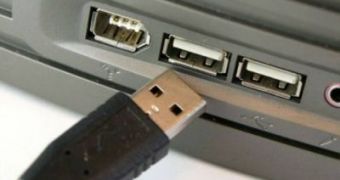The Universal Serial Bus or USB for short is a very popular port today as there are maybe a million computer hardware parts that connect to the host system using it. Among those parts, or better said peripherals, there are mice, keyboards, external storage devices, webcams flash memory sticks and so on. The USB port is not at its third major revision, having reached version 2.0, which is intended to completely replace the older and slower versions 1.0 and 1.1.
While there are a ton of USB compatible peripherals on the market today, they all need different power levels in order to operate properly and this is where problems start. Some external storage solutions like Buffalo's 80GB USB-based hard disk drive, or HDD for short, require more power under certain condition than a single USB port is able to provide. While all USB ports offer the same power voltage, namely 5 volts, they often differ at the amperage departments according to the news site Zdnet. As the USB port standard was originally designed for mice, keyboards and flash memory sticks that need only a trickle of power to function, it appears that 500 milliamps is the norm in most computer system but there are some implementations that offer more. The site cites Brian Verenkoff from Buffalo Technology saying that "Any device you plug into a USB port on a computer and do not plug into an AC adapter is running at 5v and generally low amperage".
While 500ma is enough power for mice and flash sticks, in the case of a 3.5 inch USB based hard disk drive or another similar devices, another energy feeding cable is needed as the USB port is used only for data transfers. As a USB hard disk drive contains a modified HDD in it with two motors, one to rotate the platters and one to move the heads, a greater amount of power is needed than the one provided by the USB port. "A 2.5?? USB HDD (portable HDD) is one of the few devices that has moving parts that can still be powered by the limited amperage of many USB ports". There are two solutions to this problem. One is to simply use another USB cable in order to deliver the required power to the external hardware components and one cable for the data transfer. While this solution takes up an additional USB port, on most modern day computers that come with motherboards equipped with a medium of ten ports, this should not be a problem.
Another solution is to use a completely different method and power the device, most probable an external storage device, from the main power grid. While this solution has the advantage of freeing up one USB port, it drastically limits the usability of said device in situations where an external power source is not available.

 14 DAY TRIAL //
14 DAY TRIAL //